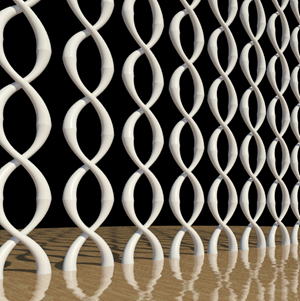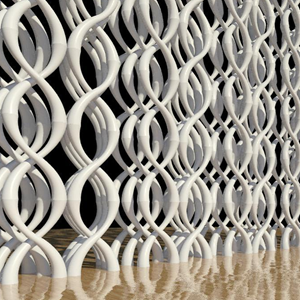I spend a far amount of time travelling each week from where I live in the UK to London. I travel mostly by train as it gives me time to do "stuff" as well as experiment with Revit on my laptop. I often get an idea which I want to try and then it turns into mini design study with many options! Most of them are a load of rubbish to be honest, but it does give me to chance to push Revit to see what can be achieved. Although Revit doesn't provide you with organic tools that products such as 3dsmax, Maya, Rhino and Alias Studio offer, you can still create some interesting forms.
So using the same method described in my previous post, nesting generic families into a cw family, I created these. You will see a common theme as well as how each one was pushed on to create even more complex patterns.
This is the cw panel family, which consisted of swept blends.
This version again consists of swept blends, but in a heliacal form.
This is the swept blend, driven vertically.
Most of these are a bit out there! But it was fun creating them, I hope they inspire.








8 comments :
Very nice David :)
Here's some more info on Erwin Hauer:
http://www.core.form-ula.com/2008/09/20/erwin-hauer/
some REALLY neat concepts in there..
i'm curious though, how flexible are those if the grids change size? or are you limited to the original size of the panels?
David, don't know if my first post sent right or not..
love the concepts. i'm curious however as to how flexible these panels are. is it limited to the size of the grid or will it flex?
thanks ahead of time, and keep up the really interesting concepts!
David,
That looks unreal!!! I love the look of the single Helical one. Keep up the great posts!
JB
How well does Revit perform in creating these complex forms and repeating them with curtain walls (as opposed to arrays)?
Dave B,
Thanks for the comments and the link! Its inspired me to move into yet another direction. :-) Watch this space.
Archmedia,
In the case of all these examples. they are really limited by the grid size, as the panel matches the grid size. I suppose if I could think a bit harder I could drive the panel with parameters.
Architect,
This is an interesting point. These panel systems can get rather heavy, but from experience and comments from others, I generally try to avoid arrays because they can add even more weight and can be rather slow. Although I can't officially comment on the true maths difference, maybe others will be able to confirm this.
Post a Comment